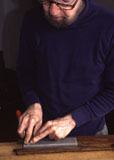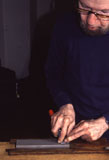

|
|
Table
of contents
|
|
A
Guide to Honing and Sharpening
Moving
the Blade on the Stone
You should
not move the blade along the stone until you can
get the bevel to "click down" properly. With that mastered,
the next step is moving the chisels back and forth on the stone
while still keeping the bevel in constant contact with the stone.
Hint:
At first, try stopping at the end of each stoke to check the solidity
of the down holding pressure on the bevel. The bevel should "click"
against the stone. As your hold-down technique becomes consistent,
you can progress to continuous back and forth strokes.
Click on the picture to enlarge
|
 |
To
move along stone: keep arms firm; sway with body from left to right.
- Move chisel along stone back and forth over whole length, in a long
"W" pattern that will cover entire surface of stone. |
 |
Stance
is a very important. If you try to move your arms, it will be harder
to maintain pressure on the bevel and keep the bevel flat on the
stone. However, if you sway your body and keep your arms firmly
against your sides as your body moves, your arms will naturally
follow and you will be able to move the chisel easily without the
bevel teetering on the stone.
|
 |
Move
the chisel back and forth over the entire length and width of the
stone, tracing out a series of "W" patterns over the length
of the stone. As shown in the pictures, the chisel is held at a diagonal
angle to the stone This sideways position with the chisel held diagonally
(Ex. A) will prove more stable than the strict, CHISEL-LINED-UP-WITH-THE-STONE
position shown in (Ex. B). |
|
The "W" Pattern
|
Example A
|
Example B
|
|
|
|
|
|
| This
back and forth "W" motion, with your body leading your hands
so that the bevel will naturally stay flat on the stone, is the main
action of all sharpening. Practice this motion carefully and slowly
and it will become second nature. Use the entire length and width
of the stone: that's what it's there for. (For waterstones, this last
point is very important as it evens out wear considerably.) |
A
Figure 8 motion, which is often recommended in old woodworking
textbooks, has several drawbacks. The curve at the beginning and
end of a stroke throws you out of solid contact with the stone's
straight surface, and requires a more complex muscular response
to maintain equilibrium - especially with thin bladed, i.e., narrow
beveled, plane irons. Furthermore, it does tend to induce a curved
edge on any tool, since pressure and metal removed are more concentrated
at the bevel's corner with the swerve of each pass.
Note:
The Figure8 style of honing is necessary in the honing of curved
blades.
|


|
